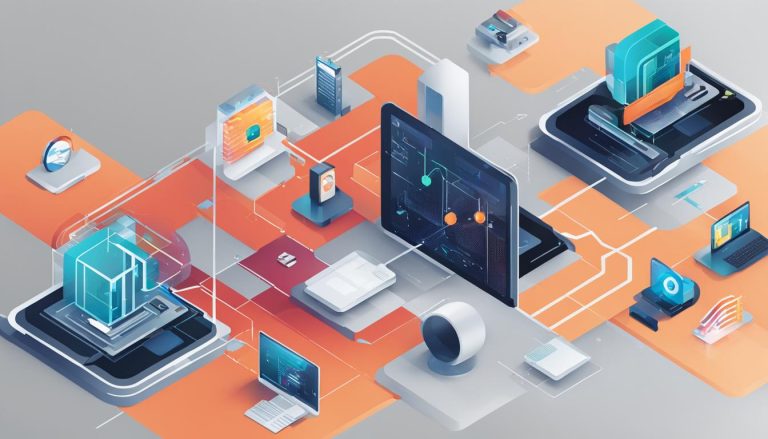Welcome to the world of networking, where information flows like a well-orchestrated symphony. In this article, we will dive into the fascinating realm of packets – the building blocks of data transmission over computer networks. So, what exactly is a packet? Let me break it down for you.
A packet is a fundamental unit of data that is bundled together and sent across a network. It carries crucial address information and is a part of a complete message. Just like a postal package, a packet consists of a header, payload, and sometimes a trailer. The header contains instructions, the payload carries the actual data, and the trailer holds additional information.
The size and structure of a packet depend on the underlying network protocol. Its main purpose is to find the best route to reach its intended destination. Think of packets as messengers navigating through the vast network, ensuring the efficient and reliable delivery of your information.
Key Takeaways:
- A network packet is a basic unit of data transferred over a computer network
- It consists of a header, payload, and, optionally, a trailer
- Packets work by choosing the best route to reach their destination
- They ensure efficient and reliable transmission of information
- The size and structure of a packet depend on the network protocol
The Parts of a Network Packet
A network packet consists of three essential components: the packet header, payload, and trailer. Each of these elements plays a crucial role in ensuring the successful transmission of data across a computer network.
Packet Header
The packet header contains a set of instructions that provide important information about the data being transmitted. It includes details such as the version of the protocol being used, the length of the packet, the type of service, total length, identification, flags, fragment offset, time to live (TTL), protocol, header checksum, source address, destination address, and options. The packet header serves as a guide for routers and switches to properly route the packet to its intended destination.
Payload
The payload is the actual data that is being transmitted within the packet. It can vary in size and content depending on the application and the information being sent. The payload is typically padded with zero bits to ensure that the packet reaches its required length. It carries the vital information that needs to be transmitted from the source to the destination.
Trailer
The trailer is an optional part attached to the end of the packet. It can contain additional information about the packet or serve as a means of error detection and correction. The trailer is used to verify the integrity of the packet and ensure that it has been received without any errors during the transmission. While not always present, the trailer adds an extra layer of reliability to the packet.
Understanding the different parts of a network packet is essential in comprehending how data is transmitted across networks. Each component serves a specific purpose and contributes to the overall successful delivery of information.
How Packets Work
Packets work by utilizing a process called packet switching to efficiently route data across networks. When a packet is sent from a source device, it is divided into smaller units and assigned a source and destination address. These packets then traverse the network independently and are reassembled at the destination. This method allows for efficient use of network resources by utilizing different paths for packet delivery.
Packet switching offers several advantages over other methods of data transmission. Firstly, it enables load balancing, which means that packets can be distributed across different network paths, reducing congestion and improving overall network performance. Additionally, packet switching allows for the retransmission of lost or corrupted packets, ensuring reliable data delivery.
However, packet loss can still occur in certain situations, such as when network congestion is high or due to hardware or software failures. Despite this, packets are designed to choose the best available route to their destination, allowing them to navigate congested parts of the network without significantly slowing down the overall data transmission process.
Packet Delivery Process
The process of packet delivery involves several key steps:
- Packetization: The original data is broken down into smaller packets, each containing a portion of the data.
- Routing: Each packet is assigned a source and destination address, allowing routers to determine the best path for delivery.
- Transmission: The packets are transmitted across the network, with each router making independent decisions on how to forward the packets towards their destination.
- Reassembly: Upon arrival at the destination, the packets are reassembled in the correct order to reconstruct the original data.
Overall, the packet switching method used by packets allows for efficient and reliable data transmission, making it a fundamental component of modern networking systems.
Benefits of Using Packets
Using packets for data transmission offers several benefits. By sending data in smaller packets, transmission rates can be improved. Instead of waiting for a large chunk of data to be sent, packets allow for a more efficient and continuous flow of information. This not only speeds up the transfer process but also reduces the likelihood of data congestion.
Packets also enable the sharing of the same connection among multiple devices. With the use of packet switching, different paths can be utilized to route packets, ensuring efficient packet delivery and avoiding network bottlenecks. This allows for better utilization of network resources and improved overall performance.
Furthermore, packets can be encrypted to ensure secure delivery. By adding encryption to the packets, the data transmitted becomes more secure, protecting it from unauthorized access or interception. This is particularly important when dealing with sensitive information, such as financial transactions or personal data.
Packet analysis is another valuable aspect of using packets. It allows for the examination of packet headers and payload to gain insights into network performance and troubleshooting. By analyzing packets, network administrators can identify potential issues, detect network anomalies, and optimize the network infrastructure for better efficiency.
| Benefits of Using Packets | |
|---|---|
| Efficient data transmission | The use of smaller packets improves transmission rates and reduces data congestion. |
| Shared connection | Packets enable multiple devices to use the same connection, optimizing network resources. |
| Secure delivery | By encrypting packets, data transmission becomes more secure, protecting sensitive information. |
| Packet analysis | Examining packets provides insights into network performance and troubleshooting. |
Packet Switching vs Circuit Switching
When it comes to connecting devices in telecommunications, two main methods are commonly used: packet switching and circuit switching. Both of these methods serve different purposes and have distinct characteristics that make them suitable for specific applications.
Packets Switching
Packet switching is a method used to route data packets over a connectionless network, such as the internet. It breaks down data into small packets and sends them individually from the source to the destination. Each packet is independently routed based on the best available path, and they can take different routes to reach the same destination. This flexibility allows for efficient use of network resources and enables the transmission of different types of data simultaneously.
Packet switching is particularly useful for data-intensive applications, such as file transfers and internet browsing. It offers scalability, as packets can be routed dynamically according to network conditions. However, it does introduce some overhead due to the additional header information added to each packet.
Circuit Switching
On the other hand, circuit switching is used primarily for voice networks and requires the dedication of a specific path for the duration of the connection. This means that a direct communication path is established between the source and the destination, and it remains open for the entire duration of the call.
This method guarantees a continuous connection and ensures real-time communication without delays or disruptions. It is commonly used for voice and video calls, where a constant and uninterrupted connection is essential. However, circuit switching may not be as efficient for data transmission as packet switching, as it requires dedicated resources for the entire duration of the call, even during periods of silence.
Comparison
In summary, packet switching offers flexibility, efficient use of network resources, and the ability to handle different types of data. It is widely used for data transmission over connectionless networks, such as the internet. On the other hand, circuit switching guarantees a continuous and dedicated connection for real-time communication, making it suitable for voice networks.
| Packet Switching | Circuit Switching |
|---|---|
| Breaks down data into packets | Dedicated connection for the entire duration of the call |
| Flexible routing based on best available path | Direct communication path established |
| Economical use of network resources | Guaranteed continuous connection |
| Suitable for data-intensive applications | Primarily used for voice networks |
The Differences Between Packets and Frames
In computer networking, packets and frames are both essential components that facilitate the transmission of data. However, they are used in different layers of the network protocol stack – packets in the network layer and frames in the data link layer. Understanding the differences between packets and frames is crucial for comprehending the intricacies of network communication.
Packet
Packets are units of data transmission at the network layer. They encapsulate the payload (actual data) with a header that contains address information. The packet header includes details such as source and destination IP addresses, protocol information, and other necessary instructions for routing and delivery. Unlike frames, packets typically do not have a trailer section.
Frame
Frames, on the other hand, are used at the data link layer of the network protocol stack. They encapsulate packets and include additional protocol control information within the frame header. This information helps in error detection and correction, flow control, and frame synchronization. Frames also have a trailer section that contains error-checking mechanisms like a frame check sequence (FCS).
The distinction between packets and frames allows for a clear differentiation between the network layer and the data link layer in networking protocols. Packets focus on addressing and routing, while frames handle the reliability and synchronization aspects of data transmission.
Packet vs Frame: A Comparison
| Packets | Frames |
|---|---|
| Used at the network layer | Used at the data link layer |
| Contain address information in the header | Contain protocol control information in the header |
| Do not have a trailer section | Have a trailer section with error-checking mechanisms |
| Focused on addressing and routing | Handle reliability and synchronization |
By understanding the distinctions between packets and frames, network engineers and administrators can effectively design and troubleshoot network infrastructure. The proper utilization of packets and frames ensures efficient and reliable data transmission, contributing to seamless network communication.
Understanding the differences between packets and frames is crucial for comprehending the intricacies of network communication.
Key takeaway:
Packets and frames serve different functions in network communication. Packets are used at the network layer to encapsulate data and address information, while frames operate at the data link layer to provide reliability and synchronization. Recognizing these distinctions is vital for optimizing network performance and troubleshooting potential issues.
Disclaimer: The information provided in this article is for educational purposes only and should not be considered as professional advice.
Conclusion
In conclusion, packets play a crucial role in modern networking systems. They are the fundamental units of data transmission, allowing for efficient and reliable communication over computer networks. A network packet is composed of a header, payload, and, optionally, a trailer. The header contains essential instructions and address information, while the payload carries the actual data.
Packets work by choosing the best available route to reach their destination. This routing process is determined based on network conditions and the information provided in the packet header. Packet switching is used to route packets through different paths, ensuring efficient delivery and load balancing. Although packet loss can occur, packets are designed to be retransmitted and use the best available route, allowing them to navigate congested network areas without compromising speed.
Using packets for data transmission offers numerous benefits. By breaking down data into smaller packets, transmission rates can be improved. Additionally, packets allow for the sharing of the same connection among multiple devices, enabling efficient packet delivery. They can also be encrypted to ensure secure transmission. Furthermore, packet analysis provides valuable insights into network performance and facilitates troubleshooting.
Understanding the differences between packets and frames is essential in comprehending the various layers of the network protocol stack. Packets are used in the network layer and contain address information, while frames are used in the data link layer and include additional protocol control information. Clear differentiation between these units helps avoid confusion and ensures smooth communication throughout the network.
FAQ
What is a network packet?
A network packet is a basic unit of data that is grouped together and transferred over a computer network. It carries pertinent address information and is part of a complete message.
What are the parts of a network packet?
A network packet consists of three parts: the packet header, payload, and trailer. The packet header contains instructions related to the data, the payload carries the actual data, and the trailer is an optional end part attached to the packet.
How do packets work?
Packets work by choosing the best route available to their destination. This route is determined based on network conditions and the information in the packet header. Packet switching is used to route packets to their destination through different paths, improving efficiency and load balancing.
What are the benefits of using packets for data transmission?
Using packets for data transmission offers several benefits. They allow for improved transmission rates, the sharing of the same connection among multiple devices, efficient packet delivery using different paths, secure delivery through encryption, and valuable insights into network performance and troubleshooting through packet analysis.
What is the difference between packet switching and circuit switching?
Packet switching is used for routing data packets over a connectionless network like the internet, offering flexibility, efficient use of network resources, and the ability to handle different types of data. Circuit switching, on the other hand, is used for voice networks and requires the dedication of a specific path for the duration of the connection.
What are the differences between packets and frames?
Packets are used in the network layer and carry address information, while frames are used in the data link layer and contain additional protocol control information. Frames encapsulate packets and include a header and a trailer, while packets usually only have a header. Understanding this distinction helps in comprehending the different layers of the network protocol stack.
Hi, I’m Mark, the author of Clever IT Solutions: Mastering Technology for Success. I am passionate about empowering individuals to navigate the ever-changing world of information technology. With years of experience in the industry, I have honed my skills and knowledge to share with you. At Clever IT Solutions, we are dedicated to teaching you how to tackle any IT challenge, helping you stay ahead in today’s digital world. From troubleshooting common issues to mastering complex technologies, I am here to guide you every step of the way. Join me on this journey as we unlock the secrets to IT success.


